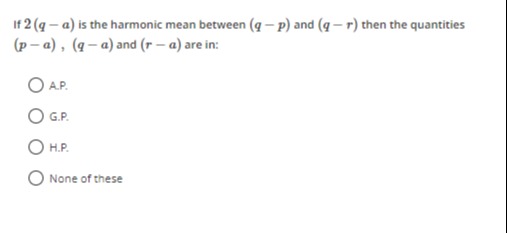Question
Question: If 2(q-a) is the harmonic mean between (q-p) and (q-r) then the quantities (p-a), (q-a) and (r-a) ar...
If 2(q-a) is the harmonic mean between (q-p) and (q-r) then the quantities (p-a), (q-a) and (r-a) are in:

A
A.P.
B
G.P.
C
H.P.
D
None of these
Answer
G.P.
Explanation
Solution
The harmonic mean (HM) of two numbers A and B is given by H=A+B2AB. Given that 2(q−a) is the harmonic mean between (q−p) and (q−r), we have: 2(q−a)=(q−p)+(q−r)2(q−p)(q−r) Dividing by 2: (q−a)=(q−p)+(q−r)(q−p)(q−r) Let X=p−a, Y=q−a, and Z=r−a. Then: q−p=(q−a)−(p−a)=Y−X q−r=(q−a)−(r−a)=Y−Z Substituting these into the equation: Y=(Y−X)+(Y−Z)(Y−X)(Y−Z) Y[(Y−X)+(Y−Z)]=(Y−X)(Y−Z) Y(2Y−X−Z)=Y2−YZ−YX+XZ 2Y2−XY−YZ=Y2−YZ−YX+XZ Y2=XZ This condition implies that X,Y,Z are in Geometric Progression (G.P.).
